Potential Applications of 5G Network Technology for Climate Change Control: A Scoping Review of Singapore
Abstract
:1. Introduction
2. Climate Change Risk Factors
3. Benefits of 5G Technology Applications against Climate Change-Related Risk Factors
3.1. Smart Energy Management
3.2. Smart Wastes Management
3.3. Water Resources Management
3.4. Agriculture Management
3.5. Risk Management
3.6. Economic Management
4. 5G Smart Cities
5. Challenges, Recommendations and Future Works
- The concept of the smart city will continue to evolve. Yet, only the developed countries are engaged in such experimentation and implementation. Singapore is one of the leading nations taking initiatives to employ citywide sensor data to monitor daily life. Singapore’s Smart Nation program encompasses current technology infrastructure to create an online connection for all the involved communities. Smart cities have wide-ranging benefits that can be applied to any urban area. Hence, future studies on cost-effective design and implementation are essential to increase the focus on the smart city concept globally. It is also vital to include renewable energy sources so as to safeguard the viability of city operations, addressing the various issues related to the non-renewable energy sources;
- Future smart cities should comprehensively examine the big data analytics of the existing smart cities;
- In the connected environments, it is critical to safeguard the security of sensitive data, because in the case of any doubt, the citizens may not utilize the ICT platforms, thereby decreasing the city operations’ viability and reliability. Hence, a key area for future research may be the implementation of collective security measures in smart cities;
- The other area that requires an in-depth investigation is the optimization of the advantages of diverse devices. Further analyses are required because smart cities integrate a range of subsystems at the application layer in order to provide reliable and efficient services. Due to its universal accessibility, the web inspired WoT concept is considered as an ideal element to combine diverse applications. Consequently, smart city constituents can effectively intercommunicate regardless of any conflicting components in the communication technologies or operational platforms.
6. Conclusions
- The necessity of a high bandwidth, low latency, and customized network for supporting various network-related requirements including smart facilities management that cannot be fulfilled with the current networks was demonstrated;
- The 5G technologies-enabled smart cities concept has been prioritized in Singapore to maintain public comfort within the buildings, energy efficiency, environmentally friendliness, and intelligence. It is expected that the intelligent buildings in the near future will become more significant in the context of large buildings;
- Low rise institutional buildings and schools have the potential to achieve zero or positive energy targets first;
- The smart management of energy, wastes, water resources, agricultures, risk factors, and economy adopted in smart cities can remarkably contribute to reducing climate change, thus attaining the sustainability goals.
- The smartest management depends on the applications of the developed technologies such as IoTs, artificial intelligence, and so forth. In fact, 5G network technology can provide ultra-high transfer speeds, ultra-low latency, ultra-reliable experiences, ultra-high connection density, ultra-high traffic density, and ultra-high mobility access to the users. In addition, it can offer enhanced networks spectral and energy efficiency at lower operational and maintenance costs;
- Singapore has committed to reducing GHG emissions remarkably by 2030. The buildings sector, which consumes more than one-third of the country’s total electricity, can play a major role in reducing the carbon footprint upon implementing the concept of smart cities, mitigating climate change.
- In short, the new 5G network technology will have substantial positive influence on energy, waste, risk, water resources, and economic management, thereby leading to more sustainability with lower climate change impacts.
Author Contributions
Funding
Institutional Review Board Statement
Informed Consent Statement
Data Availability Statement
Acknowledgments
Conflicts of Interest
Abbreviations
| GHGs | Global greenhouse gases |
| IoT | Internet of things |
| NZE | Net zero energy |
| NUS | National University of Singapore |
| CO2 | Carbon dioxide emission |
| NH4 | methane |
| MEWR | Ministry of the environment and water resources |
| IWMF | Integrated waste management facility |
| SGS | Singapore smart garbage system |
| SGBs | Smart garbage bins |
| ILFI | international living future institute |
| GPS | Global positioning system |
| NEA | national environment agency |
| ICRM | Institute for Catastrophe Risk Management |
References
- De Coninck, H.C. IPCC SR15: Summary for Policymakers. In IPCC Special Report Global Warming of 1.5 °C; Intergovernmental Panel on Climate Change: Geneva, Switzerland, 2018. [Google Scholar]
- Cobacho, S.P.; Wanke, S.; Konstantinou, Z.; El Serafy, G. Impacts of shellfish reef management on the provision of ecosystem services resulting from climate change in the Dutch Wadden Sea. Mar. Policy 2020, 119, 104058. [Google Scholar] [CrossRef]
- Shah, K.W.; Huseien, G.F. Biomimetic Self-Healing Cementitious Construction Materials for Smart Buildings. Biomimetics 2020, 5, 47. [Google Scholar] [CrossRef]
- Huseien, G.F.; Mirza, J.; Ismail, M.; Ghoshal, S.K.; Hussein, A.A. Geopolymer mortars as sustainable repair material: A comprehensive review. Renew. Sustain. Energy Rev. 2017, 80, 54–74. [Google Scholar] [CrossRef]
- Goldberg, M.H.; Gustafson, A.; van der Linden, S. Leveraging Social Science to Generate Lasting Engagement with Climate Change Solutions. One Earth 2020, 3, 314–324. [Google Scholar] [CrossRef]
- Taillardat, P.; Thompson, B.S.; Garneau, M.; Trottier, K.; Friess, D.A. Climate change mitigation potential of wetlands and the cost-effectiveness of their restoration. Interface Focus 2020, 10, 20190129. [Google Scholar] [CrossRef] [PubMed]
- Masson-Delmotte, V.; Zhai, P.; Pörtner, H.-O.; Roberts, D.; Skea, J.; Shukla, P.R. ShuklaGlobal warming of 1.5 °C. An IPCC Special Report on the impacts of global warming of 1.5 °C above pre-industrial levels and related global greenhouse gas emission pathways, in the context of strengthening the global response to the threat of climate change, sustainable development, and efforts to eradicate poverty. Sustain. Dev. Efforts Eradicate Poverty 2018, 1, 1–9. [Google Scholar]
- Cabeza, L.F.; Barreneche, C.; Miró, L.; Morera, J.M.; Bartolí, E.; Fernández, A.I. Low carbon and low embodied energy materials in buildings: A review. Renew. Sustain. Energy Rev. 2013, 23, 536–542. [Google Scholar] [CrossRef]
- Archer, D. The Long Thaw: How Humans Are Changing the next 100,000 Years of Earth’s Climate; Princeton University Press: Princeton, NJ, USA, 2016; Volume 44. [Google Scholar]
- Ruddiman, W.F. The anthropogenic greenhouse era began thousands of years ago. Clim. Chang. 2003, 61, 261–293. [Google Scholar] [CrossRef]
- Kennedy, C.; Steinberger, J.; Gasson, B.; Hansen, Y.; Hillman, T.; Havranek, M.; Mendez, G.V. Greenhouse Gas. Emissions from Global Cities; ACS Publications: Washington, DC, USA, 2009. [Google Scholar]
- Olivier, J.G.; Schure, K.; Peters, J. Trends in Global CO2 and Total Greenhouse Gas. Emissions; PBL Netherlands Environmental Assessment Agency: Hague, The Netherlands, 2017; Volume 5.
- Williams, J.H.; DeBenedictis, A.; Ghanadan, R.; Mahone, A.; Moore, J.; Morrow, W.R.; Torn, M.S. The technology path to deep greenhouse gas emissions cuts by 2050: The pivotal role of electricity. Science 2012, 335, 53–59. [Google Scholar] [CrossRef] [Green Version]
- Birch, E.L.; Wachter, S.M. Global Urbanization; University of Pennsylvania Press: Philadelphia, PA, USA, 2011. [Google Scholar]
- Jin, J.; Gubbi, J.; Marusic, S.; Palaniswami, M. An information framework for creating a smart city through internet of things. IEEE Internet Things J. 2014, 1, 112–121. [Google Scholar] [CrossRef]
- Hammi, B.; Khatoun, R.; Zeadally, S.; Fayad, A.; Khoukhi, L. IoT technologies for smart cities. IET Netw. 2017, 7, 1–13. [Google Scholar] [CrossRef]
- Scuotto, V.; Ferraris, A.; Bresciani, S. Internet of Things: Applications and challenges in smart cities. A case study of IBM smart city projects. Bus. Process. Manag. J. 2016. [Google Scholar] [CrossRef]
- Nnaji, C.C.; Utsev, J.T. Climate Change and Waste Management: A Balanced Assessment. J. Sustain. Dev. Afr. 2011, 13, 17–34. [Google Scholar]
- Rosenzweig, C.; Iglesius, A.; Yang, X.B.; Epstein, P.R.; Chivian, E. Climate change and extreme weather events-Implications for food production, plant diseases, and pests. Glob. Chang. Hum. Health 2001, 2, 90–94. [Google Scholar] [CrossRef]
- Hoegh-Guldberg, O.; Bruno, J.F. The impact of climate change on the world’s marine ecosystems. Science 2010, 328, 1523–1528. [Google Scholar] [CrossRef]
- Leibensperger, E.; Mickley, L.J.; Jacob, D.J.; Chen, W.T.; Seinfeld, J.H.; Nenes, A.; Rind, D. Climatic effects of 1950–2050 changes in US anthropogenic aerosols—Part 2: Climate response. Atmos. Chem. Phys. 2012, 12, 3349–3362. [Google Scholar] [CrossRef] [Green Version]
- Rosenberg, S.; Vedlitz, A.; Cowman, D.F.; Zahran, S. Climate change: A profile of US climate scientists’ perspectives. Clim. Chang. 2010, 101, 311–329. [Google Scholar] [CrossRef]
- Boemare, C.; Quirion, P. Implementing greenhouse gas trading in Europe: Lessons from economic literature and international experiences. Ecol. Econ. 2002, 43, 213–230. [Google Scholar] [CrossRef] [Green Version]
- Binti Sa’adin, S.L.; Kaewunruen, S.; Jaroszweski, D. Risks of Climate Change with Respect to the Singapore-Malaysia High Speed Rail System. Climate 2016, 4, 65. [Google Scholar] [CrossRef] [Green Version]
- Paudel, P.; Bhattarai, A. 5G telecommunication technology: History, overview, requirements and use case scenario in context of Nepal. In Proceedings of the ICT4D Conference, Lusaka, Zambia, 30 April–2 May 2018. [Google Scholar]
- Ahad, M.A.; Paiva, S.; Tripathi, G.; Feroz, N. Enabling Technologies and Sustainable Smart Cities. Sustain. Cities Soc. 2020, 61, 102301. [Google Scholar] [CrossRef]
- Jia, M.; Komeily, A.; Wang, Y.; Srinivasan, R.S. Adopting Internet of Things for the development of smart buildings: A review of enabling technologies and applications. Autom. Constr. 2019, 101, 111–126. [Google Scholar] [CrossRef]
- Ullah, Z.; Al-Turjman, F.; Mostarda, L.; Gagliardi, R. Applications of Artificial Intelligence and Machine learning in smart cities. Comput. Commun. 2020, 154, 313–323. [Google Scholar] [CrossRef]
- Chew, M.Y.L.; Teo, E.A.L.; Shah, K.W.; Kumar, V.; Hussein, G.F. Evaluating the Roadmap of 5G Technology Implementation for Smart Building and Facilities Management in Singapore. Sustainability 2020, 12, 10259. [Google Scholar] [CrossRef]
- United States Environmental Protection Agency. Inventory of US Greenhouse Gas. Emissions and Sinks: 1990–2011; United States Environmental Protection Agency: Washington, DC, USA, 2013; Volume 505.
- Moradkhani, E. Climate Change and Energy Management Strategies. Comput. Water Energy Environ. Eng. 2017, 6, 143–153. [Google Scholar] [CrossRef]
- Dovì, V.G.; Friedler, F.; Huisingh, D.; Klemeš, J.J. Cleaner energy for sustainable future. J. Clean. Prod. 2009, 17, 889–895. [Google Scholar] [CrossRef]
- Deng, S.; Wang, R.; Dai, Y. How to evaluate performance of net zero energy building—A literature research. Energy 2014, 71, 1–16. [Google Scholar] [CrossRef]
- D’Agostino, D.; Mazzarella, L. What is a Nearly zero energy building? Overview, implementation and comparison of definitions. J. Build. Eng. 2019, 21, 200–212. [Google Scholar] [CrossRef]
- Alaloul, W.S.; Musarat, M.A. Impact of Zero Energy Building: Sustainability Perspective. In Sustainable Sewage Sludge Management and Resource Efficiency; IntechOpen: London, UK, 2020. [Google Scholar]
- Marjaba, G.; Chidiac, S. Sustainability and resiliency metrics for buildings—Critical review. Build. Environ. 2016, 101, 116–125. [Google Scholar] [CrossRef]
- Doan, D.T.; Ghaffarianhoseini, A.; Naismith, N.; Zhang, T.; Ghaffarianhoseini, A.; Tookey, J. A critical comparison of green building rating systems. Build. Environ. 2017, 123, 243–260. [Google Scholar] [CrossRef]
- Wong, J.K.W.; Zhou, J. Enhancing environmental sustainability over building life cycles through green BIM: A review. Autom. Constr. 2015, 57, 156–165. [Google Scholar] [CrossRef]
- Azhar, S.; Carlton, W.A.; Olsen, D.; Ahmad, I. Building information modeling for sustainable design and LEED® rating analysis. Autom. Constr. 2011, 20, 217–224. [Google Scholar] [CrossRef]
- Perlova, E.; Platonova, M.; Gorshkov, A.; Rakova, X. Concept project of zero energy building. Procedia Eng. 2015, 100, 1505–1514. [Google Scholar] [CrossRef] [Green Version]
- Fedorczak-Cisak, M.; Furtak, M.; Gintowt, J.; Kowalska-Koczwara, A.; Pachla, F.; Stypuła, K.; Tatara, T. Thermal and vibration comfort analysis of a nearly zero-energy building in Poland. Sustainability 2018, 10, 3774. [Google Scholar] [CrossRef] [Green Version]
- Baden, S.; Fairey, P.; Waide, P.; de T’serclaes, P.; Laustsen, J. Hurdling financial barriers to low energy buildings: Experiences from the USA and Europe on financial incentives and monetizing building energy savings in private investment decisions. In Proceedings of the 2006 ACEEE Summer Study on Energy Efficiency in Buildings, Washington, DC, USA, 26 August 2006. [Google Scholar]
- Marszal, A.J.; Heiselberg, P.; Bourrelle, J.S.; Musall, E.; Voss, K.; Sartori, I.; Napolitano, A. Zero Energy Building—A review of definitions and calculation methodologies. Energy Build. 2011, 43, 971–979. [Google Scholar] [CrossRef]
- Attia, S. Net Zero Energy Buildings (NZEB): Concepts, Frameworks and Roadmap for Project Analysis and Implementation; Butterworth-Heinemann: Oxford, UK, 2018. [Google Scholar]
- Onyanta, A. Cities, municipal solid waste management, and climate change: Perspectives from the South. Geogr. Compass 2016, 10, 499–513. [Google Scholar] [CrossRef]
- Kweku, D.W.; Bismark, O.; Maxwell, A.; Desmond, K.A.; Danso, K.B.; Oti-Mensah, E.A.; Adormaa, B.B. Greenhouse effect: Greenhouse gases and their impact on global warming. J. Sci. Res. Rep. 2017, 1–9. [Google Scholar] [CrossRef]
- Soussana, J.-F.; Allard, V.; Pilegaard, K.; Ambus, P.; Amman, C.; Campbell, C.; Valentini, R. Full accounting of the greenhouse gas (CO2, N2O, CH4) budget of nine European grassland sites. Agric. Ecosyst. Environ. 2007, 121, 121–134. [Google Scholar] [CrossRef]
- Bogner, J.; Pipatti, R.; Hashimoto, S.; Diaz, C.; Mareckova, K.; Diaz, L.; Gregory, R. Mitigation of global greenhouse gas emissions from waste: Conclusions and strategies from the Intergovernmental Panel on Climate Change (IPCC) Fourth Assessment Report. Working Group III (Mitigation). Waste Manag. Res. 2008, 26, 11–32. [Google Scholar] [CrossRef]
- De Cara, S.; Houzé, M.; Jayet, P.-A. Methane and nitrous oxide emissions from agriculture in the EU: A spatial assessment of sources and abatement costs. Environ. Resour. Econ. 2005, 32, 551–583. [Google Scholar] [CrossRef]
- Kula, E. Economics of Natural Resources, the Environment and Policies; Springer Science & Business Media: Berlin/Heidelberg, Germany, 2012. [Google Scholar]
- Beaver, J.R.; Manis, E.E.; Loftin, K.A.; Graham, J.L.; Pollard, A.I.; Mitchell, R.M. Land use patterns, ecoregion, and microcystin relationships in US lakes and reservoirs: A preliminary evaluation. Harmful Algae 2014, 36, 57–62. [Google Scholar] [CrossRef]
- Beard, S.; Holt, L.; Tzachor, A.; Kemp, L.; Avin, S.; Torres, P.; Belfield, H. Assessing climate change’s contribution to global catastrophic risk. Futures 2021, 127, 102673. [Google Scholar] [CrossRef]
- Robinson, B.H. E-waste: An assessment of global production and environmental impacts. Sci. Total Environ. 2009, 408, 183–191. [Google Scholar] [CrossRef]
- Esmaeilian, B.; Wang, B.; Lewis, K.; Duarte, F.; Ratti, C.; Behdad, S. The future of waste management in smart and sustainable cities: A review and concept paper. Waste Manag. 2018, 81, 177–195. [Google Scholar] [CrossRef]
- Mdukaza, S.; Isong, B.; Dladlu, N.; Abu-Mahfouz, A.M. Analysis of IoT-enabled solutions in smart waste management. In Proceedings of the IECON 2018-44th Annual Conference of the IEEE Industrial Electronics Society, Washington, DC, USA, 21–23 October 2018. [Google Scholar]
- SBallal, V.; Patil, S.S.; Dange, N.P. Smart City Waste Management System using IoT SERVER. Management 2019, 6, 955–958. [Google Scholar]
- Ng, B.J.H.; Mao, Y.; Chen, C.L.; Rajagopal, R.; Wang, J.Y. Municipal food waste management in Singapore: Practices, challenges and recommendations. J. Mater. Cycles Waste Manag. 2017, 19, 560–569. [Google Scholar] [CrossRef]
- Mehmood, Y.; Ahmad, F.; Yaqoob, I.; Adnane, A.; Imran, M.; Guizani, S. Internet-of-things-based smart cities: Recent advances and challenges. IEEE Commun. Mag. 2017, 55, 16–24. [Google Scholar] [CrossRef]
- Bharadwaj, A.S.; Rego, R.; Chowdhury, A. IoT based solid waste management system: A conceptual approach with an architectural solution as a smart city application. In Proceedings of the 2016 IEEE Annual India Conference (INDICON), Bangalore, India, 16–18 December 2016. [Google Scholar]
- Shirke, S.; Ithape, S.; Lungase, S.; Mohare, M. Automation of smart waste management using IoT. Int. Res. J. Eng. Technol. 2019, 6, 414–419. [Google Scholar]
- Shahinzadeh, H.; Mirhedayati, A.S.; Shaneh, M.; Nafisi, H.; Gharehpetian, G.B.; Moradi, J. IoT architecture for smart grids. In Proceedings of the 2019 International Conference on Protection and Automation of Power System (IPAPS), Tehran, Iran, 8–9 January 2019. [Google Scholar]
- Chaudhari, M.S.; Patil, B.; Raut, V. IoT based Waste Collection Management System for Smart Cities: An Overview. In Proceedings of the 2019 3rd International Conference on Computing Methodologies and Communication (ICCMC), Erode, India, 27–29 March 2019. [Google Scholar]
- Abbaspour, K.C.; Faramarzi, M.; Ghasemi, S.S.; Yang, H. Assessing the impact of climate change on water resources in Iran. Water Resour. Res. 2009, 45. [Google Scholar] [CrossRef] [Green Version]
- DeNicola, E.; Aburizaiza, O.S.; Siddique, A.; Khwaja, H.; Carpenter, D.O. Climate change and water scarcity: The case of Saudi Arabia. Ann. Glob. Health 2015, 81, 342–353. [Google Scholar] [CrossRef]
- Babel, M.S.; Bhusal, S.P.; Wahid, S.M.; Agarwal, A. Climate change and water resources in the Bagmati River Basin, Nepal. Theor. Appl. Climatol. 2014, 115, 639–654. [Google Scholar] [CrossRef]
- Mahmood, R.; Jia, S.; Babel, M.S. Potential impacts of climate change on water resources in the Kunhar River Basin, Pakistan. Water 2016, 8, 23. [Google Scholar] [CrossRef] [Green Version]
- Wadekar, S.; Vakare, V.; Prajapati, R.; Yadav, S.; Yadav, V. Smart water management using IOT. In Proceedings of the 2016 5th International Conference on Wireless Networks and Embedded Systems (WECON), Rajpura, India, 14–16 October 2016. [Google Scholar]
- Rajurkar, C.; Prabaharan, S.; Muthulakshmi, S. IoT based water management. In Proceedings of the 2017 International Conference on Nextgen Electronic Technologies: Silicon to Software (ICNETS2), Chennai, India, 23–25 March 2017. [Google Scholar]
- Pincheira, M.; Vecchio, M.; Giaffreda, R.; Kanhere, S.S. Exploiting constrained IoT devices in a trustless blockchain-based water management system. In Proceedings of the 2020 IEEE International Conference on Blockchain and Cryptocurrency (ICBC), Toronto, ON, Canada, 2–6 May 2020. [Google Scholar]
- Sekaran, K.; Meqdad, M.N.; Kumar, P.; Rajan, S.; Kadry, S. Smart agriculture management system using internet of things. Telkomnika 2020, 18, 1275–1284. [Google Scholar] [CrossRef]
- Hu, X.; Qian, S. IoT application system with crop growth models in facility agriculture. In Proceedings of the 2011 6th International Conference on Computer Sciences and Convergence Information Technology (ICCIT), Seogwipo, Korea, 29 November–2 December 2011. [Google Scholar]
- Bing, F. Research on the agriculture intelligent system based on IOT. In Proceedings of the 2012 International Conference on Image Analysis and Signal Processing, Hangzhou, China, 9–11 November 2012. [Google Scholar]
- Wang, C.; Daneshmand, M.; Dohler, M.; Mao, X.; Hu, R.Q.; Wang, H. Guest Editorial-Special issue on internet of things (IoT): Architecture, protocols and services. IEEE Sens. J. 2013, 13, 3505–3510. [Google Scholar] [CrossRef]
- Wang, C.; Bi, Z.; da Xu, L. IoT and cloud computing in automation of assembly modeling systems. IEEE Trans. Ind. Inform. 2014, 10, 1426–1434. [Google Scholar] [CrossRef]
- Zhang, X.; Zhang, J.; Li, L.; Zhang, Y.; Yang, G. Monitoring citrus soil moisture and nutrients using an iot based system. Sensors 2017, 17, 447. [Google Scholar] [CrossRef] [PubMed]
- Kim, S.; Lee, M.; Shin, C. IoT-based strawberry disease prediction system for smart farming. Sensors 2018, 18, 4051. [Google Scholar] [CrossRef] [Green Version]
- Tuli, A.; Hasteer, N.; Sharma, M.; Bansal, A. Framework to leverage cloud for the modernization of the Indian agriculture system. In Proceedings of the IEEE International Conference on Electro/Information Technology, Milwaukee, WI, USA, 5–7 June 2014. [Google Scholar]
- Zhao, J.-C.; Zhang, J.F.; Feng, Y.; Guo, J.X. The study and application of the IOT technology in agriculture. In Proceedings of the 2010 3rd International Conference on Computer Science and Information Technology, Chengdu, China, 9–11 July 2010. [Google Scholar]
- Ning, H.; Wang, Z. Future internet of things architecture: Like mankind neural system or social organization framework? IEEE Commun. Lett. 2011, 15, 461–463. [Google Scholar] [CrossRef]
- Yan-e, D. Design of intelligent agriculture management information system based on IoT. In Proceedings of the 2011 Fourth International Conference on Intelligent Computation Technology and Automation, Shenzhen, China, 28–29 March 2011. [Google Scholar]
- Ma, J.; Zhou, X.; Li, S.; Li, Z. Connecting agriculture to the internet of things through sensor networks. In Proceedings of the 2011 International Conference on Internet of Things and 4th International Conference on Cyber, Physical and Social Computing, Dalian, China, 19–22 October 2011. [Google Scholar]
- Kunreuther, H.; Heal, G.; Allen, M.; Edenhofer, O.; Field, C.B.; Yohe, G. Risk management and climate change. Nat. Clim. Chang. 2013, 3, 447–450. [Google Scholar] [CrossRef] [Green Version]
- Aldunce, P.; Beilin, R.; Howden, M.; Handmer, J. Resilience for disaster risk management in a changing climate: Practitioners’ frames and practices. Glob. Environ. Chang. 2015, 30, 1–11. [Google Scholar] [CrossRef]
- Davis, S.J.; Lewis, N.S.; Shaner, M.; Aggarwal, S.; Arent, D.; Azevedo, I.L.; Benson, S.M.; Bradley, T.; Brouwer, J.; Chiang, Y.-M.; et al. Net-zero emissions energy systems. Science 2018, 360, 6396. [Google Scholar] [CrossRef] [Green Version]
- Malik, V.; Singh, S. Internet of Things: Risk Management, in Smart Systems and IoT: Innovations in Computing; Springer: Berlin/Heidelberg, Germany, 2020; pp. 419–427. [Google Scholar]
- Tol, R.S. The economic impacts of climate change. Rev. Environ. Econ. Policy 2018, 12, 4–25. [Google Scholar] [CrossRef] [Green Version]
- Venkatramanan, V.; Shah, S.; Prasad, R. Global Climate Change: Resilient and Smart Agriculture; Springer: Berlin/Heidelberg, Germany, 2020. [Google Scholar]
- Alliance, N. 5G White Paper. Next Generation Mobile Networks; White Paper; NGMN: Frankfurt, Germany, 2015; Volume 1. [Google Scholar]
- Markopoulos, I.; Valcarenghi, L.; Mesogiti, I.; Taferner, M.; Boleguin, P.; Bouali, F.; Cattoni, A. The 5G Infrastructure Public Private Partnership (5G PPP) White Paper on “Service Performance Measurement Methods over 5G Experimental Networks”; Coventry University: London, UK, 2021. [Google Scholar]
- Del Rio, D.D.F.; Sovacool, B.K.; Bergman, N.; Makuch, K.E. Critically reviewing smart home technology applications and business models in Europe. Energy Policy 2020, 144, 111631. [Google Scholar] [CrossRef]
- Daissaoui, A.; Boulmakoul, A.; Karim, L.; Lbath, A. IoT and Big Data Analytics for Smart Buildings: A Survey. Procedia Comput. Sci. 2020, 170, 161–168. [Google Scholar] [CrossRef]
- D’Elia, A.; Roffia, L.; Zamagni, G.; Vergari, F.; Bellavista, P.; Toninelli, A.; Mattarozzi, S. Smart applications for the maintenance of large buildings: How to achieve ontology-based interoperability at the information level. In Proceedings of the The IEEE symposium on Computers and Communications, Riccione, Italy, 22–25 June 2010. [Google Scholar]
- Chunjiang, Y. Development of a smart home control system based on mobile internet technology. Int. J. Smart Home 2016, 10, 293–300. [Google Scholar] [CrossRef]
- Viswanath, S.K.; Yuen, C.; Tushar, W.; Li, W.T.; Wen, C.K.; Hu, K.; Liu, X. System design of the internet of things for residential smart grid. IEEE Wirel. Commun. 2016, 23, 90–98. [Google Scholar] [CrossRef] [Green Version]
- Mak, K.-K.; Pichika, M.R. Artificial intelligence in drug development: Present status and future prospects. Drug Discov. Today 2019, 24, 773–780. [Google Scholar] [CrossRef] [PubMed]
- Newaz, A.I.; Sikder, A.K.; Rahman, M.A.; Uluagac, A.S. Healthguard: A machine learning-based security framework for smart healthcare systems. In Proceedings of the 2019 Sixth International Conference on Social Networks Analysis, Management and Security (SNAMS), Granada, Spain, 22–25 October 2019. [Google Scholar]
- Kim, J.; Jo, G.; Jeong, J. A Novel CPPS Architecture Integrated with Centralized OPC UA server for 5G-based Smart Manufacturing. Procedia Comput. Sci. 2019, 155, 113–120. [Google Scholar] [CrossRef]
- Åkerman, M.; Lundgren, C.; Bärring, M.; Folkesson, M.; Berggren, V.; Stahre, J.; Friis, M. Challenges building a data value chain to enable data-driven decisions: A predictive maintenance case in 5G-Enabled manufacturing. Procedia Manuf. 2018, 17, 411–418. [Google Scholar] [CrossRef]
- Walia, J.S.; Hämmäinen, H.; Kilkki, K.; Yrjölä, S. 5G network slicing strategies for a smart factory. Comput. Ind. 2019, 111, 108–120. [Google Scholar] [CrossRef]
- Orange, J.S.-B.; Armada, A.G.; Evans, B.; Galis, A.; Karl, H. White Paper for Research beyond 5G; Final Edit; Networld (NW), NGMN: Frankfurt, Germany, 2020; pp. 1–43. [Google Scholar]
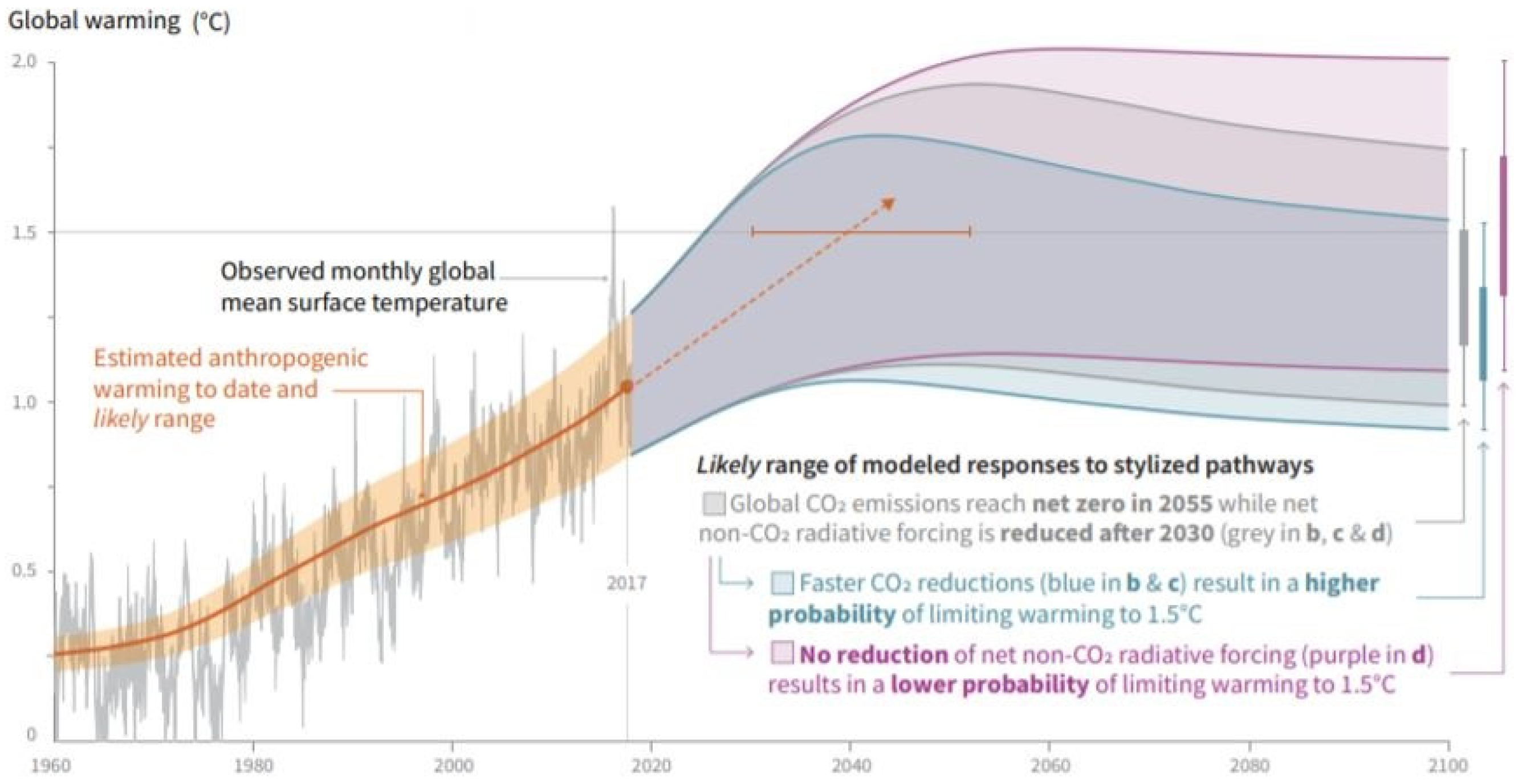
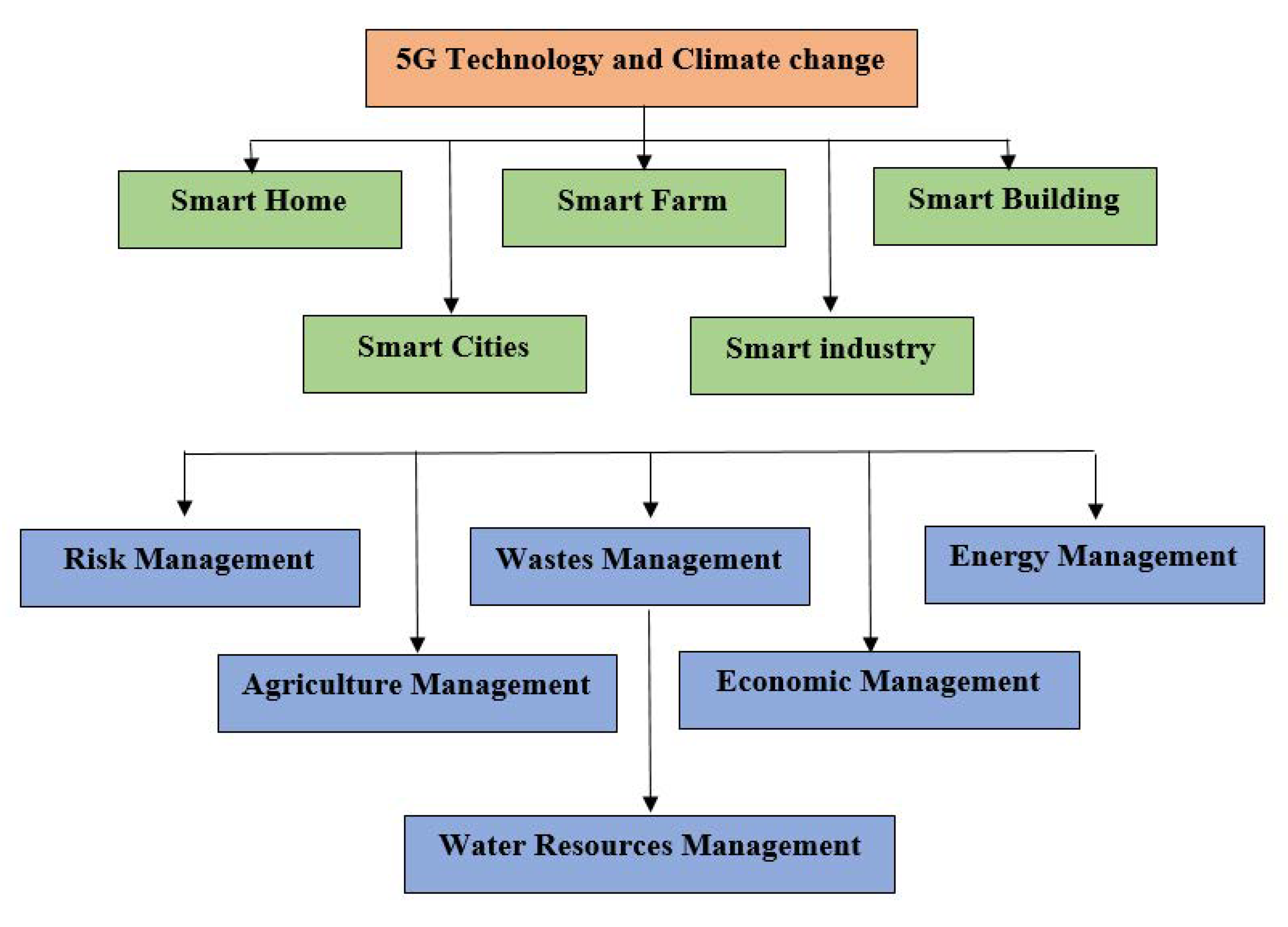
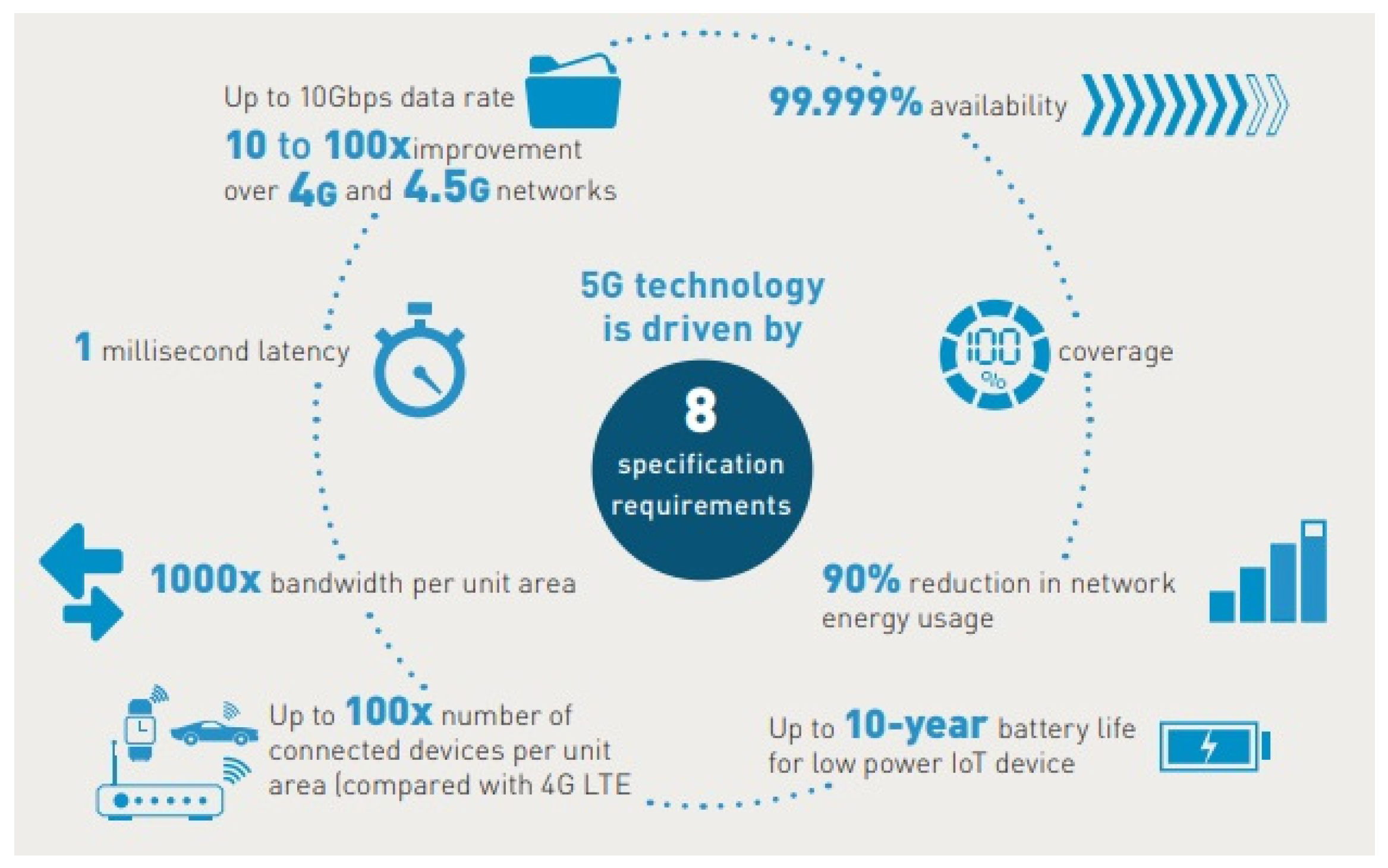
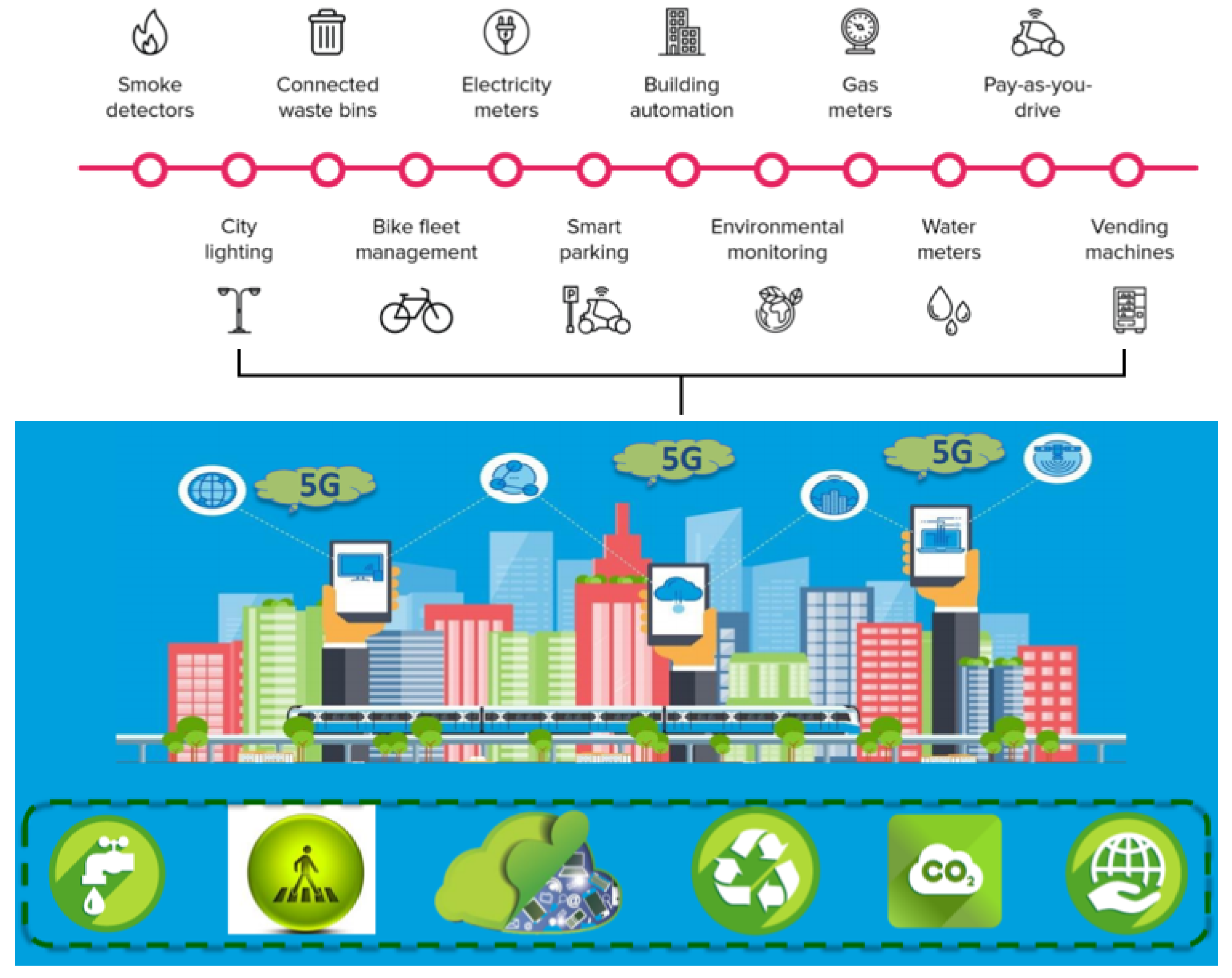

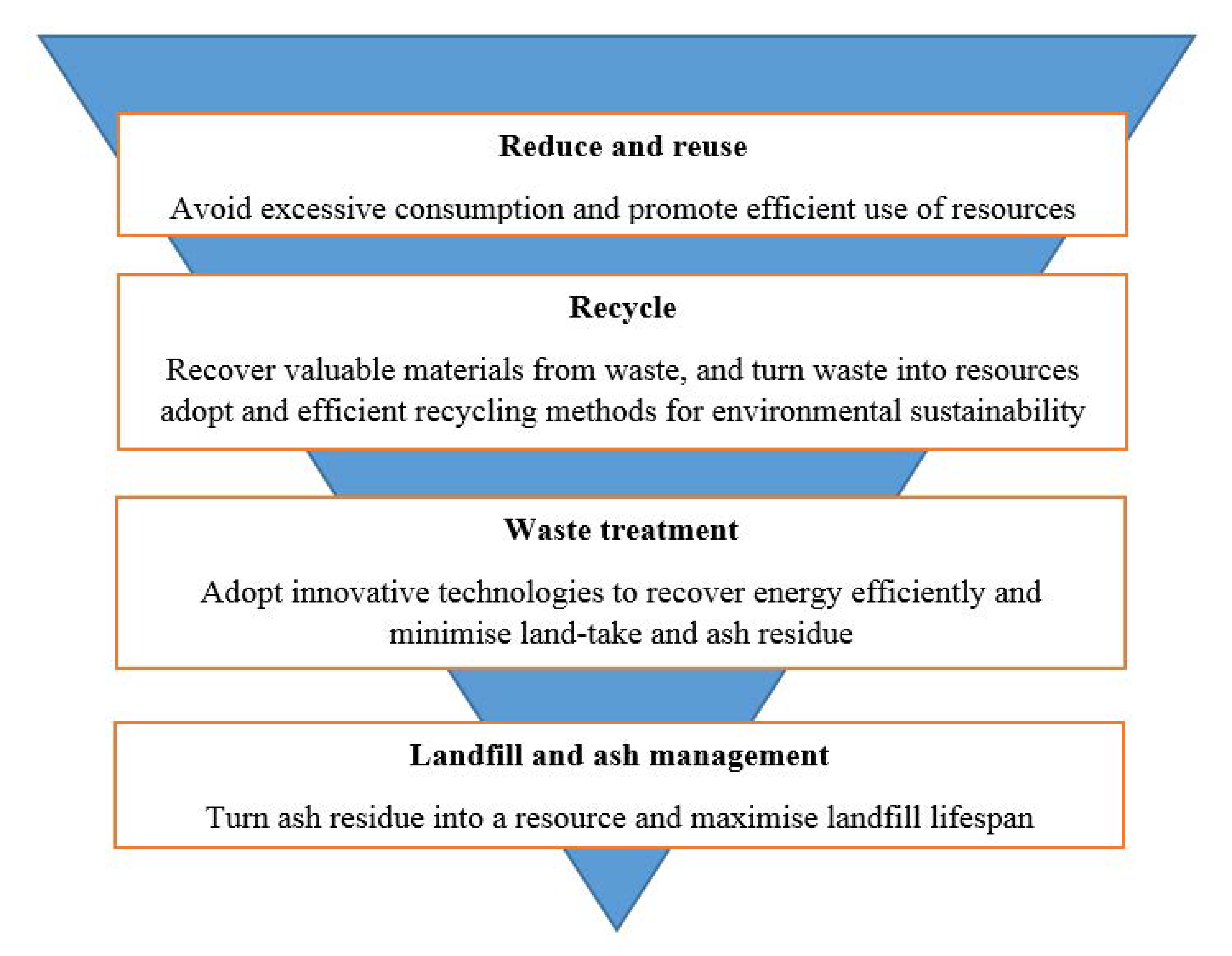
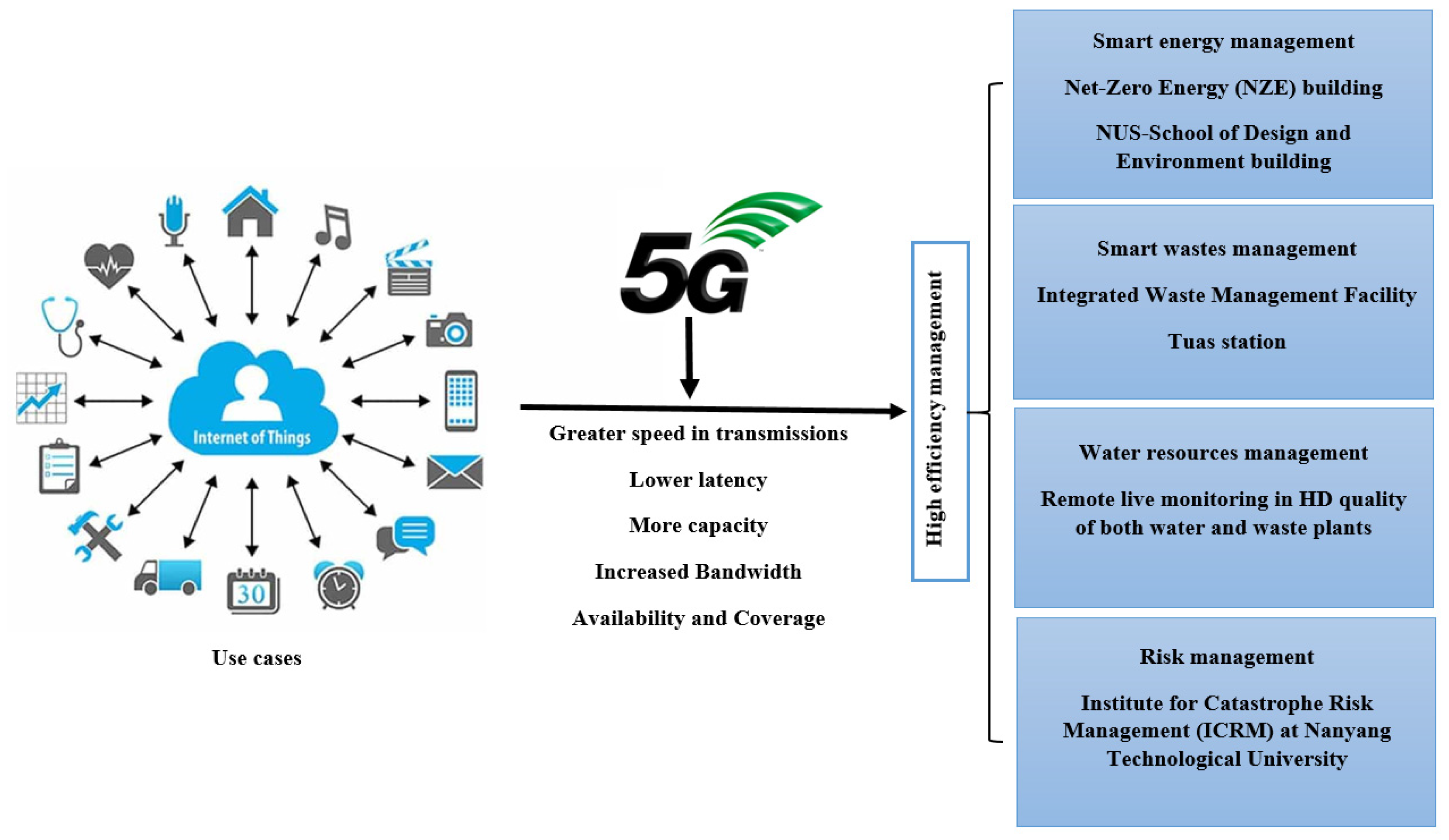
| Direct GHG | CO2 Fossil | CH4 | N2O |
|---|---|---|---|
| Emissions (Mt) | 3.215 | 22 | 1.05 |
| GWP (over 100 Years) | 1 | 21 | 310 |
| Global Warming Equivalence of all emissions Mt equiv CO2 (% from solid waste disposal) | 3.215 (<0.5%) | 460 (33%) | 325 (1%) |
| Global warming equivalence emissions from waste disposal Mt equiv CO2 (% of total waste management component for each gas) | 15 (9%) | 152 (89%) | 3 (2%) |
| Ref. | Country | Building Type | Major Use Case | Related Building System |
|---|---|---|---|---|
| [92] | Italy | Business building | IoT | Building maintenance applications for end users |
| [93] | China | Hospital | IoT | Occupant localization for hospital department route direction |
| [94] | Singapore | Residential building | IoT | Smart grid (energy control) system for residential building. |
| [95] | Malaysia | Hospital | AI | Using AI for drug discovery applications. |
| [96] | USA | Hospital | Machine learning | HealthGuard platform to continuously monitors and compare the connected devices operations and body conditions. |
| [97] | South Korea | Smart factory | AI | Improve the efficiency of horizontal data distribution and exchange operations, reduce the time and cost, the problem of data loss, system performance degradation, real-time processing delays, and the ability to accommodate a number of machines and a number of single protocol products. |
| [98] | Sweden | Smart industry | AI | predictive maintenance, big data management. |
| [99] | Finland | Smart factory | AI | The model allows for distribution of network functions between business actors over multiple network domains. |
| [100] | USA | Smart transportation | IoT | To improve traffic congestion, a smart transport system that dynamically tracks, monitors, and publishes city-wide traffic in real time has been developed. |
Publisher’s Note: MDPI stays neutral with regard to jurisdictional claims in published maps and institutional affiliations. |
© 2021 by the authors. Licensee MDPI, Basel, Switzerland. This article is an open access article distributed under the terms and conditions of the Creative Commons Attribution (CC BY) license (https://creativecommons.org/licenses/by/4.0/).
Share and Cite
Huseien, G.F.; Shah, K.W. Potential Applications of 5G Network Technology for Climate Change Control: A Scoping Review of Singapore. Sustainability 2021, 13, 9720. https://doi.org/10.3390/su13179720
Huseien GF, Shah KW. Potential Applications of 5G Network Technology for Climate Change Control: A Scoping Review of Singapore. Sustainability. 2021; 13(17):9720. https://doi.org/10.3390/su13179720
Chicago/Turabian StyleHuseien, Ghasan Fahim, and Kwok Wei Shah. 2021. "Potential Applications of 5G Network Technology for Climate Change Control: A Scoping Review of Singapore" Sustainability 13, no. 17: 9720. https://doi.org/10.3390/su13179720
APA StyleHuseien, G. F., & Shah, K. W. (2021). Potential Applications of 5G Network Technology for Climate Change Control: A Scoping Review of Singapore. Sustainability, 13(17), 9720. https://doi.org/10.3390/su13179720







